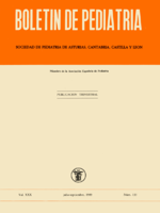Epiglotitis aguda en la infancia
G. Milano Manso , C. Calvo Macías , J. Trigo Moreno , Mª.C. Martínez Ferriz , A. Martínez Valverde
Bol. Pediatr. 1989; 30 (133): 233 - 238
Se revisan 10 casos de epiglotitis habidos en una UCI pediátrica durante 4 años, comentándose su baja incidencia (0,62% de los ingresos) pero su extraordinaria morbi-mortalidad si no se efectúa un diagnóstico y tratamiento rápidos. Fiebre y dificultad respiratoria se apreciaron en todos los casos, y disfonía y disfagia en el 50%. Se comentan las 2 aspectos esenciales del tratamiento: l) La Laringoscopia directa bajo anestesia inhalatoria para confirmación diagnóstica e intubación nasotraqueal reglada, con especiales cuidados posteriores en UCIP y 2) La antibioterapia específica frente al H. influenzae tipo b por ser el agente etiológico habitual. La evolución de los casos fue buena, salvo uno con hipoxia cerebral post-parada cardíaca previa al ingreso en UCIP.
Acute epiglottitis in childhood
Ten cases of Epiglottitis were diagnosed in a Pediatric Intensive Care Unit over a four year period. We find the incidence to be low, 0,62% of adrnissions, and the morbi-mortality to be very high if diagnosis and treatment are late. Fever and respiratory distress appeared in every case, disfagia and disphonia in 50% of them. Two essential aspects of care are reviewed: 1. Direct laringoscopy, under general inhalatory anestesia to ascertain diagnosis and perfom naso-traqueal intubation. 2. Specific antimicrobial therapy against type B H. Influenzae, the usual aetiologic agent. The outcome was good in all but one case, in which cardiac arrest with cerebral Hypoxia occurred prior to admission in Paediatric Intensive Care Unit. KEY WORDSE: PIGLO~TISU. PPERA IRWAYO BSTRUCTIORNE.S PIRATORY
INSUFICIENCY.
Artículo completo (PDF) (284 kb.)
- Urgencias/UCIP
